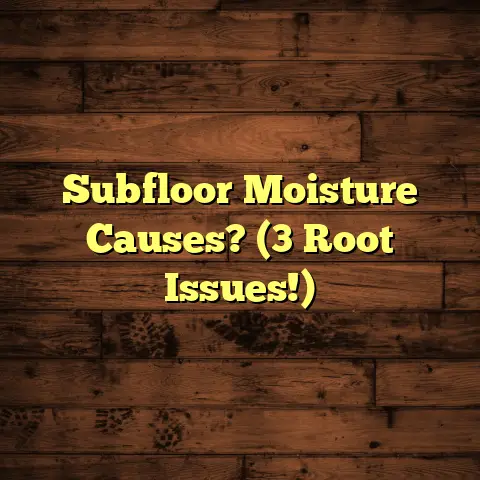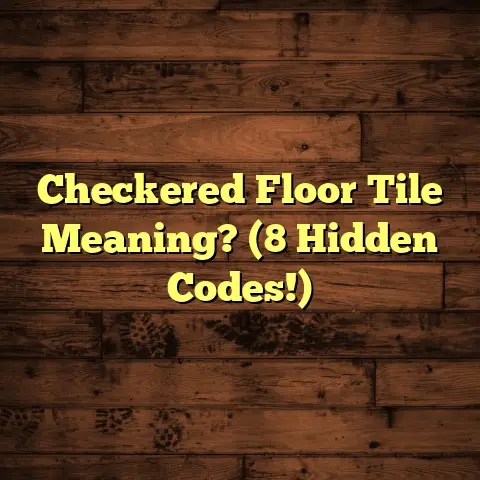Fix Hardwood Floor Gaps? (4 DIY Tricks!)
Imagine walking into your living room on a crisp fall evening.
The fireplace crackles merrily, casting a warm, inviting glow.
You sink into your favorite armchair, a soft blanket draped over you.
The rich, polished hardwood floors underfoot add a touch of elegance.
But wait… what’s that?
Gaps?
Those pesky little lines between your floorboards.
They’re not just unsightly; they can also let in drafts, collect dirt, and even cause long-term damage.
Don’t worry, you’re not alone!
As a flooring contractor with years of experience, I’ve seen it all.
And the good news is, you can often tackle these gaps yourself with a few simple DIY tricks.
Let’s dive in and get those floors looking their best!
Understanding Hardwood Floor Gaps
First things first, let’s understand why these gaps appear in the first place.
It’s not always a sign of poor installation.
In fact, it’s often a natural process.
Wood is a hygroscopic material, meaning it absorbs and releases moisture from the air.
Think of it like a sponge.
- Humidity: High humidity causes wood to expand.
- Dry Air: Low humidity causes it to contract.
Think about it: In the humid summer months, your hardwood floors are likely swollen with moisture.
Then, winter rolls around with dry, heated air, and the wood shrinks, creating those annoying gaps.
Seasonal vs. Permanent Gaps
It’s important to distinguish between seasonal and permanent gaps:
Seasonal Gaps: These appear and disappear with the changing seasons.
They’re usually nothing to worry about, just the natural movement of the wood.Permanent Gaps: These remain consistent year-round.
They could indicate a more serious issue, such as improper installation, subfloor problems, or excessive moisture fluctuations.
How can you tell the difference?
Observe your floors throughout the year.
If the gaps close up in the summer and reappear in the winter, they’re likely seasonal.
If they’re always there, it’s time to investigate further.
Before you start any repairs, take a close look at the gaps.
Are they uniform in size, or are some wider than others?
This will help you determine the best course of action.
Now, let’s get to the fun part: fixing those gaps!
DIY Trick #1: Wood Filler
Wood filler is a classic solution for filling small to medium-sized gaps in hardwood floors.
It’s relatively easy to use and can create a seamless, professional-looking repair.
Choosing the Right Wood Filler
Not all wood fillers are created equal.
Here’s what to consider when making your selection:
- Type: There are two main types of wood filler:
- Water-based: Easy to clean up and low in odor.
- Solvent-based: More durable and water-resistant, but can be more difficult to work with and have a strong odor.
- Color: Choose a wood filler that closely matches the color of your floor.
You can also mix different colors to create a custom blend. - Grain: Some wood fillers contain wood fibers to mimic the natural grain of wood.
This can help create a more realistic repair.
I often recommend using a stainable wood filler, even if you don’t plan to stain it.
This allows you to fine-tune the color with a stain marker or artist’s paint if needed.
Step-by-Step Guide to Applying Wood Filler
Here’s a detailed guide to filling gaps with wood filler:
Prepare the Surface:
- Clean the area around the gap with a vacuum cleaner and a damp cloth.
Remove any dirt, dust, or debris. - Use a putty knife or scraper to remove any loose or flaking finish around the gap.
- Lightly sand the edges of the gap with fine-grit sandpaper (220-grit) to create a smooth surface.
- Clean the area around the gap with a vacuum cleaner and a damp cloth.
-
Apply the Wood Filler:
- Using a putty knife, scoop out a small amount of wood filler.
- Press the filler firmly into the gap, making sure to fill it completely.
- Overfill the gap slightly, as the filler will shrink as it dries.
- Use the putty knife to smooth the surface of the filler, removing any excess.
- For wider gaps, you may need to apply the filler in layers, allowing each layer to dry completely before applying the next.
Sanding:
- Allow the wood filler to dry completely according to the manufacturer’s instructions.
This can take anywhere from a few hours to overnight. - Once the filler is dry, sand it smooth with fine-grit sandpaper (220-grit).
- Use a sanding block or orbital sander to ensure a flat, even surface.
- Be careful not to sand too much, as you could damage the surrounding floor finish.
- Allow the wood filler to dry completely according to the manufacturer’s instructions.
Finishing:
- Clean the area with a vacuum cleaner and a tack cloth to remove any sanding dust.
- Apply a matching finish to the filled area.
This could be polyurethane, varnish, or wax. - Apply the finish in thin, even coats, allowing each coat to dry completely before applying the next.
- For best results, apply several coats of finish.
Tips for Color Matching
Color matching is crucial for a seamless repair. Here are a few tips:
- Test the Filler: Before applying the filler to the gap, test it on an inconspicuous area of the floor to ensure a good color match.
- Mix Colors: If you can’t find a perfect match, try mixing different colors of wood filler to create a custom blend.
- Use Stain: If the filler is slightly off in color, you can use a stain marker or artist’s paint to fine-tune the color after it has dried.
- Consider the Finish: The finish you apply can also affect the color of the filler.
Test the finish on a sample of the filler to ensure a good match.
I’ve found that using a gel stain can be particularly effective for color matching wood filler.
It’s easy to apply and provides excellent color control.
With a little patience and attention to detail, you can achieve a virtually invisible repair with wood filler.
DIY Trick #2: Caulk and Paint
Caulk might seem like an odd choice for filling hardwood floor gaps, but it can be an effective solution for small gaps, especially in wider plank flooring.
It’s flexible, which allows it to move with the wood as it expands and contracts.
Selecting the Proper Caulk
When choosing caulk for hardwood floors, look for these features:
- Paintable: This is essential, as you’ll need to paint the caulk to match your floor.
- Flexible: Choose a caulk that is designed for use in areas with movement, such as around windows and doors.
- Latex or Acrylic: These types of caulk are easy to clean up and are paintable.
- Color: While you’ll be painting over the caulk, choosing a color that is close to your floor’s color can help minimize the appearance of any imperfections.
I prefer using a high-quality acrylic latex caulk for this purpose.
It’s easy to work with, paintable, and provides good flexibility.
Step-by-Step Guide to Caulking and Painting
Here’s how to fill gaps with caulk and paint:
-
Prepare the Surface:
- Clean the area around the gap with a vacuum cleaner and a damp cloth.
- Remove any loose or flaking finish around the gap.
- Apply painter’s tape to the floor on either side of the gap to protect the surrounding finish.
-
Apply the Caulk:
- Cut the tip of the caulk tube at a 45-degree angle.
- Load the caulk tube into a caulking gun.
- Apply a thin, even bead of caulk into the gap.
- Use your finger or a caulk smoothing tool to smooth the caulk and remove any excess.
- Wipe away any excess caulk with a damp cloth.
Allow to Dry:
- Allow the caulk to dry completely according to the manufacturer’s instructions.
This can take anywhere from a few hours to overnight.
- Allow the caulk to dry completely according to the manufacturer’s instructions.
-
Paint:
- Apply a coat of primer to the caulked area.
- Allow the primer to dry completely.
- Apply two coats of paint that matches your floor’s color.
- Allow each coat of paint to dry completely before applying the next.
- Remove the painter’s tape.
Before-and-After Transformation
The transformation can be quite dramatic.
Before, you have unsightly gaps that detract from the beauty of your floor.
After, you have a smooth, seamless surface that blends in perfectly with the surrounding floorboards.
Here’s a simple comparison:
Caulking and painting is a quick and easy way to improve the appearance of your hardwood floors.
DIY Trick #3: Wood Strips or Splines
For larger gaps, wood filler or caulk might not be the best solution.
In these cases, using wood strips or splines can provide a more durable and aesthetically pleasing repair.
What are Wood Strips and Splines?
- Wood Strips: These are thin pieces of wood that are cut to fit snugly into the gaps between your floorboards.
- Splines: These are similar to wood strips, but they are often used to join two pieces of wood together, such as when repairing a damaged tongue-and-groove joint.
Using wood strips or splines allows you to maintain the natural aesthetics of your hardwood floor.
Measuring, Cutting, and Installing Wood Strips/Splines
Here’s a comprehensive guide:
-
Measure the Gaps:
- Use a measuring tape to measure the width and depth of the gaps you want to fill.
- Measure the gaps at several points along their length, as they may not be uniform in size.
-
Choose the Right Wood:
- Select a wood species that matches your existing floor.
- You can often find matching wood at a local lumberyard or flooring store.
-
Cut the Strips/Splines:
- Use a table saw or miter saw to cut the wood strips or splines to the correct width and depth.
- Cut the strips/splines slightly longer than the gaps to allow for a snug fit.
-
Prepare the Gaps:
- Clean the gaps with a vacuum cleaner and a damp cloth.
- Remove any loose or flaking finish around the gaps.
- Apply wood glue to the sides of the gaps.
-
Install the Strips/Splines:
- Insert the wood strips or splines into the gaps.
- Use a rubber mallet to gently tap the strips/splines into place.
- Make sure the strips/splines are flush with the surface of the floor.
-
Allow the Glue to Dry:
- Allow the wood glue to dry completely according to the manufacturer’s instructions.
-
Sand and Finish:
- Sand the strips/splines smooth with fine-grit sandpaper (220-grit).
- Apply a matching finish to the filled area.
Importance of Proper Adhesion and Finishing
Proper adhesion is crucial for ensuring the longevity of your repair.
Use a high-quality wood glue and make sure to apply it evenly to the sides of the gaps.
Finishing is also important for protecting the wood strips/splines and blending them in with the surrounding floorboards.
Use a finish that matches your existing floor and apply it in thin, even coats.
I’ve found that using a polyurethane finish provides excellent protection and durability.
DIY Trick #4: Humidity Control
The best way to fix hardwood floor gaps is to prevent them from forming in the first place.
Humidity control is key to maintaining the stability of your hardwood floors.
Humidity Control as a Preventive Measure
As I mentioned earlier, wood expands and contracts with changes in humidity.
By maintaining a consistent indoor humidity level, you can minimize this movement and prevent gaps from forming.
Using Humidifiers and Dehumidifiers
- Humidifiers: Add moisture to the air.
Use them in the winter when the air is dry. - Dehumidifiers: Remove moisture from the air.
Use them in the summer when the air is humid.
The NWFA recommends maintaining a relative humidity level between 35% and 55% for hardwood floors.
Monitoring Humidity Levels
You can monitor humidity levels with a simple hygrometer, which you can purchase at most hardware stores.
Place the hygrometer in a central location in your home and check it regularly.
Here are a few practical tips:
- Winter: Use a humidifier to maintain a humidity level between 35% and 55%.
- Summer: Use a dehumidifier to maintain a humidity level between 35% and 55%.
- Ventilation: Ensure proper ventilation in your home to prevent moisture buildup.
- Avoid Over-Watering Plants: Over-watering indoor plants can increase humidity levels.
- Fix Leaks: Repair any leaks in your plumbing or roof to prevent moisture damage.
By taking these simple steps, you can create a stable environment for your hardwood floors and prevent gaps from forming.
Bringing It All Together
Fixing hardwood floor gaps doesn’t have to be a daunting task.
With a little knowledge and the right tools, you can tackle these issues yourself and restore the beauty of your floors.
Remember to:
- Understand the Cause: Determine whether the gaps are seasonal or permanent.
- Choose the Right Solution: Select the appropriate DIY trick based on the size and nature of the gaps.
- Maintain Humidity: Control indoor humidity levels to prevent future gaps.
Regular maintenance and monitoring are essential for keeping your hardwood floors in top condition.
By taking pride in your floors and implementing these DIY tricks, you can transform your living spaces and preserve the warmth and charm of your hardwood flooring for years to come.
So, grab your tools, put on your DIY hat, and get ready to transform your floors!
You’ve got this!





